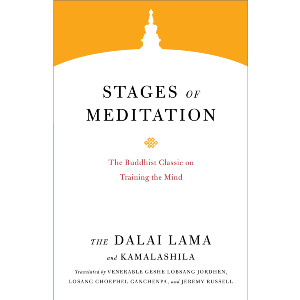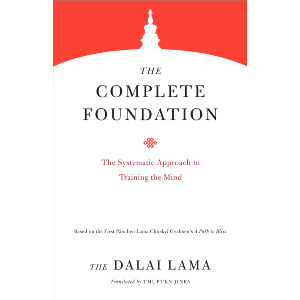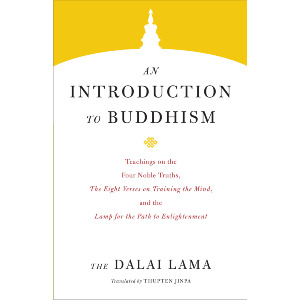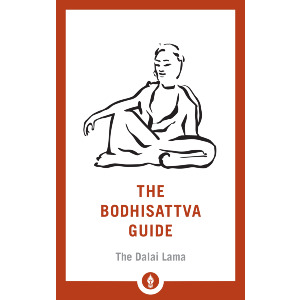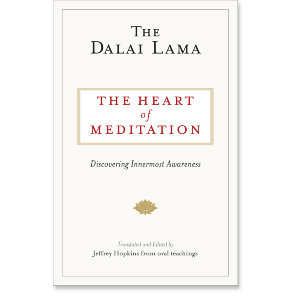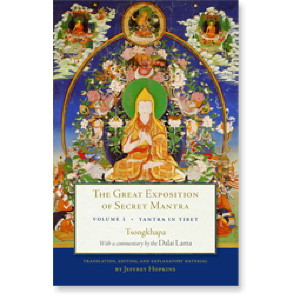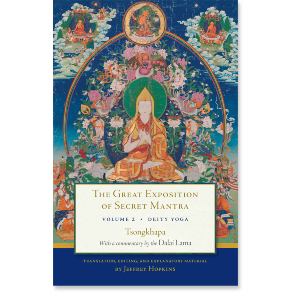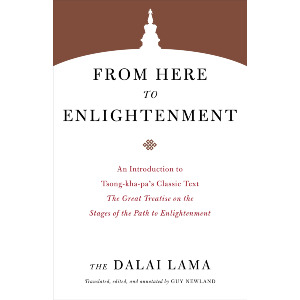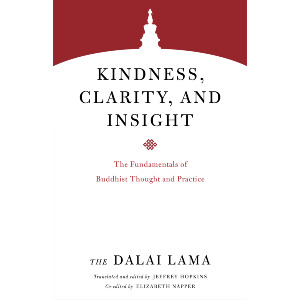| The following article is from the Winter, 2001 issue of the Snow Lion Newsletter and is for historical reference only. You can see this in context of the original newsletter here. |
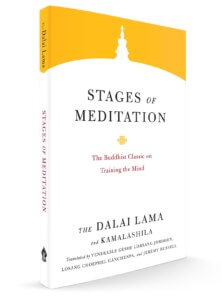
The following is an excerpt from the book's introduction.
In the words of the Superior Nagarjuna,
If you wish to attain the unsurpassed enlightenment
For yourself and the world,
The root is generation of an altruistic thought
That is stable and firm like a mountain,
An all-embracing compassion,
And a transcendent wisdom free of duality.
Those of us who desire happiness for others and ourselves temporarily and in the long term should be motivated to attain the omniscient state. Compassion, altruistic thought, and the perfect view are the fundamentals and lifeblood of the path to highest enlightenment. At this juncture, we have faith in the doctrine of Lord Buddha and have access to his teachings. We are free from the major obstacles and have met the contributory factors such that we can study the vast and profound aspects of Buddha's teaching, contemplate their contents, and meditate oh their meaning. We must therefore use all these opportunities so that we won't have cause for regret in the future and so that we don't prove unkind to ourselves. What Kadam Geshe Sang- puwa has said strikes at the central theme. This verse greatly moves me from the very heart:
Teaching and listening are proper when they are beneficial to the mind. Controlled and disciplined behavior is the sign of having heard teachings. Afflictions are reduced as a sign of meditation. A yogi is the one who understands reality.
What is the one and only purpose of Dharma teachings?
One thing that should be very clear is that Dharma teachings have only one purpose: to discipline the mind. Teachers should pay attention and see to it that their teachings benefit the minds of their students. Their instructions must be based upon their personal experience of understanding the Dharma students, too, should attend teachings with a desire to benefit their minds. They must make an all-out effort to control their undisciplined minds. I might therefore urge that we should be diligent in following the instructions of the great Kadampa Geshes. They have advised that there should be integration of the mind and Dharma. On the other hand, if knowledge and practice are treated as unrelated and distinct entities, then the training can prove ineffective. In the process of our spiritual practice, we must examine ourselves thoroughly and use Dharma as a mirror in which to see reflected the defects of our body, speech, and mind. Both the teacher and student must be motivated to benefit themselves and others through the practice of the teachings. As we find in the lam rim prayers:
Motivated by powerful compassion,
May I be able to expound the treasure of Buddhadharma,
Conveying it to new places
And places where it has degenerated.
The Buddha's doctrine is not something physical. Therefore, the restoration and spread of Buddhism depends on our inner spirit, or the continuum of our mind. When we are able to reduce the defects of the mind, its good qualities increase. Thus, effecting positive transformations is what the preservation and promotion of the Buddha's doctrine means. It is obvious that the doctrine is not a tangible entity, that it cannot be sold or bought in the marketplace or physically constructed. We should pay attention to the fundamentals, like the practice of the three trainings renunciation, the awakening mind of bodhichitta, and the wisdom realizing emptiness.
The responsibility for the preservation and furthering of Buddhist doctrine lies upon those of us who have faith in that doctrine; this in turn depends on our attraction to the Buddha and respect for him. If we don't do anything constructive and expect that others will, then obviously nothing is possible. The first step is to cultivate within our minds those positive qualities taught by the Buddha After properly disciplining our own minds, then we may hope to help discipline others' minds. The great Tsongkhapa has clearly stated that those who have not disciplined themselves have hardly any chance of disciplining others. Acharya Dharmakirti has taught this principle in very lucid terms:
When the technique is obscure [to you],
Explanation is naturally difficult.
Bodhisattvas with such an intention ultimately aim to attain the state of enlightenment. For this purpose, they engage in the practices of eliminating the disturbing emotions that afflict the mind. At the same time they endeavor to cultivate spiritual insights. It is by following such a process of eliminating negative qualities and cultivating positive ones that Bodhisattvas become capable of helping other sentient beings. The Commentary on (Dignaga's) Compendium of Valid Cognition also says:
The compassionate ones employ all means
To alleviate the miseries of beings.
How can we use the Buddha's teaching to generate virtues?
Therefore, those of us who believe in the Buddha's teachings should try our best to generate virtues. This is extremely important. It is especially relevant in this age when the Buddha's doctrine is degenerating. We Tibetans are making noise and criticizing the Chinese for the destruction they have caused in our country. But the important thing is that as followers of Buddhism we must diligently adhere to its principles. The teachings are only purposeful when we see the advantages of practicing, undertake the discipline, and effect positive transformations in our hearts. Listening to lectures on other subjects has a different purpose there we aim to gain ideas and information.
You might wonder what are the signs of a true Dharma practitioner. Practice should begin with the ethical discipline of abstaining from the ten non-virtuous actions. Every negativity of body, speech, and mind should be properly identified and its antidotes fully understood. With this basic knowledge, an individual should eliminate negative actions like stealing, lying, and so forth, and practice honesty, kindness, and other virtuous deeds. Ordained monks and nuns have to follow the rules of monastic discipline. These are meant to discipline the way one wears the monastic robes, communicates with others, and so forth. Even the manner of looking at other people and the correct ways of addressing other people are taught in the rules of monastic discipline.
The whole purpose of meditation is to lessen the deluded afflictions of our mind... a practitioner with prolonged familiarity with and meditation on selflessness eventually gains an understanding of reality.
What is the real test of a Dharma practitioner?
For a Dharma practitioner, one of the major challenges is to counter our disturbing emotions and finally free ourselves from them. The difficulty of this is due to the simple truth that disturbing emotions have from beginningless time caused us to suffer all kinds of miseries. If someone bullies us or an enemy persecutes us, then we raise a hue and cry. External enemies, however brutal they are, only affect us during one lifetime. They have no power to harm us beyond this life. On the other hand, disturbing emotions are our inner enemies and can definitely cause disaster in future lives. These are, in fact, our worst enemies.
The real test for a Dharma practitioner comes from this angle: if our disturbing emotions are reduced, then our practice has been effective. This is the main criterion in determining a true practitioner, regardless of how holy we appear externally. The whole purpose of meditation is to lessen the deluded afflictions of our mind and eventually eradicate them from their very roots. By learning and practicing the profound and vast aspects of the teaching, a practitioner with prolonged familiarity with and meditation on selflessness eventually gains an understanding of reality.
Related Books
$16.95 - Paperback
$22.95 - Paperback
$16.95 - Paperback
$12.95 - Paperback
$16.95 - Paperback
The Great Exposition of Secret Mantra, Volume 1
$29.95 - Paperback
The Great Exposition of Secret Mantra, Volume 2
$29.95 - Paperback
The Great Exposition of Secret Mantra, Volume 3
$27.95 - Paperback
$19.95 - Paperback
Kindness, Clarity, and Insight
$16.95 - Paperback


